Gulab Jamun is arguably one of the most popular Indian sweets that’s made pretty much through the year in the country. Since Gulab Jamuns are easy to make in larger quantities, it’s a popular dessert served warm with a scoop of ice cream at Diwali, weddings, parties, festivals, etc.
I really can’t think of a better day to share this delicious Gulab Jamun recipe using Khoya (or Mawa) than to start off a brand new year 2012.
One of the most common question I get when discussing Indian Sweets is “what’s that soft brown ball that’s very sweet and soaked in sugar syrup?”. Probably because gulab jamun is served at practically all Indian buffets, it’s not hard to guess which sweet they are talking about!
For all the cooking that I do, I had never tried to make gulab jamun at home, not even with the readymade boxed mix. Amma has mentioned how her mom, my aatha, makes gulab jamun with fresh, homemade khoya (mawa) and since then, I’ve wanted to try it the same way.
I realised that if I waited to make my own khoya, the gulab jamuns will never happen so I used store-bought khoya. It’s usually kept frozen so make sure to bring to room temperature before using.
Oh and by the way, khoya smells amazing. Go ahead and sniff it while it defrosts.
Key things to remember for success while making Gulab Jamun at home.
- Khoya needs to be completely soft and at room temperature
- Use a light hand when kneading the dough
- Don’t make the dough balls super smooth before frying, this can cause them to break or crack. Just roll them 90% smooth with some rough spots on the surface
- Make sure the oil is hot but not smoking hot. Ensure you fry long enough so that the inside cooks too. Keep regulating oil temperature
- The sugar syrup consistency is important but not critical, in my opinion. It shouldn’t be too thick, otherwise it won’t enter the gulab jamun and make them soft
Ok, maybe I made all of that sound intimidating but it really isn’t. Go ahead, give them a shot.
This recipe also features in the list of quick and easy Diwali Sweets recipes
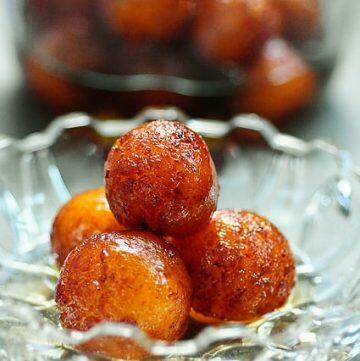
Gulab Jamun Recipe
Ingredients
For the jamun:
- 1 cup grated khoya or mawa
- 1/3 cup plain flour or maida
- ~ 1/2 cup water
- A big pinch of salt
- Oil or ghee to deep fry
For the Sugar Syrup:
- 2.5 cups sugar
- 1 cup water
- 3-4 pods of cardamom crushed
- 2 drops of rose water optional, although the name of this sweet has “rose / gulab” in it
- A few strands of saffron optional
Instructions
- 1. Grate the khoya. Mix this with the plain flour and salt.
- Note that if you are using store-bought khoya, this mixture will be quite dry. If using fresh, homemade khoya, it will be moist so you need less water for the next step.
- 2. Add sufficient water (I used around 1/2 cup) and form a stiff dough. It shouldn’t be sticky. If it is, add a bit more flour and incorporate without kneading too much.
- 3. Make into small marble-sized balls. Remember to start small because the jamuns will expand on frying and further on soaking in the sugar syrup. You don’t need to make the balls super smooth, just into small circles of even sizes (see notes above)
- 4. Heat oil to just short of smoking point and add the dough balls one by one gently. Don’t overcrowd the dough balls, fry a few at a time. This also ensures that the oil temperature doesn’t drop too much while frying.
- 5. Fry all the jamun until golden brown on medium heat, remove with a slotted spoon, and set aside.
- 6. To make the sugar syrup, mix the water and sugar and set on a medium-low flame. Stir until the sugar has dissolved completely and the mixture comes to a slow boil. Add the crushed cardamom pods, saffron and rose water if using.
- 7. Let the sugar syrup cool for about 5 mins and then dunk in the fried gulab jamun.
- 8. Partially close the pan and let the jamun soak in the sugar syrup for atl east 3-4 hours before serving.
Notes
- Gulab jamun can be served warm or cold. If warm, it tastes excellent with vanilla ice-cream.
- If the centre of the jamun is hard, that usually indicates it's undercooked and didn't fry all the way through
- If the entire jamun feels hard and doesn't seem to be absorbing the syrup, this means the dough balls got over-fried or the dough didn't have enough moisture.
- I recommend frying a small. batch first to make sure the dough is all fine and the inside is cooking, before you proceed with the rest
Gulab Jamun Step by Step Recipe
1. Mix the grated khoya with the flour and salt. If using store-bought khoya, this mixture will be quite dry. If using fresh, homemade khoya, it will be moist so you need less water for the next step.
2. Add sufficient water (I used around 1/2 cup) and form a stiff dough. It shouldn’t be sticky. If it is, add a bit more flour and incorporate without kneading too much.
3. Roll into small marble-sized balls. Remember to start small because the dough balls will expand on frying and further on soaking in the sugar syrup. You don’t have to make the balls super smooth, just into small circles of even sizes.
4. Heat oil to just short of smoking point and add the dough balls one by one gently. Don’t overcrowd the dough balls, fry a few at a time. This also ensures that the oil temperature doesn’t drop too much while frying. Consistent oil temperature is important for even frying of gulab jamun
5. Fry all the jamun until golden brown on medium heat, remove with a slotted spoon, and set aside. Don’t be alarmed if some of them crack or seem to split on the sides just a bit. If they split into two or disintegrate, time to rework the dough (see notes)
6. To make the sugar syrup, mix the water and sugar and set on a medium-low flame. Stir until the sugar has disssolved completely and the mixture comes to a slow boil. Add the crushed cardamom pods, saffron and rose water if using.
7. Let the sugar syrup cool for about 5 mins only and then dunk in the fried jamun.
8. Partially close the pan and let the jamun soak in the sugar syrup for at least 3-4 hours before serving.
Some of the sugar syrup gets absorbed by the gulab jamun but most of it remains as is so if you have any suggestions on how to use up leftover sugar syrup, please let me know. For now, I can only think of using it up for sweet godumai adai, substituting jaggery with the sugar syrup, which is what Amma does.

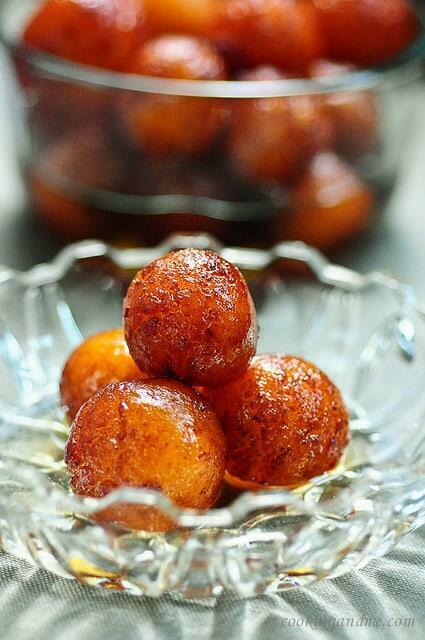
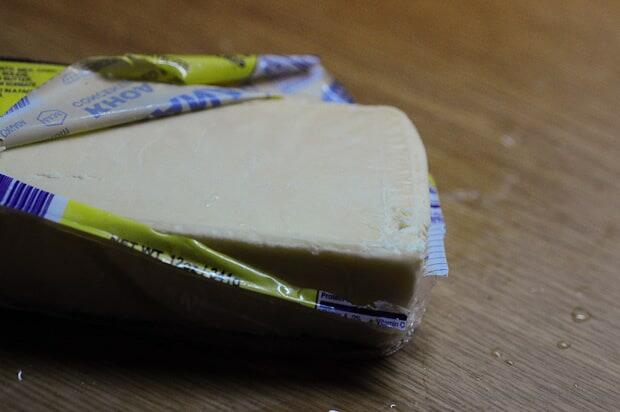
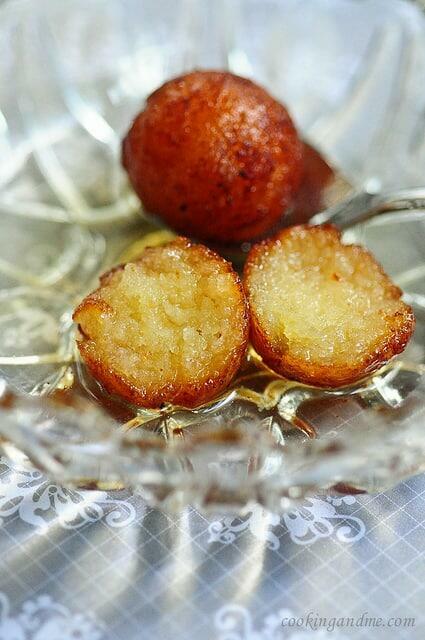
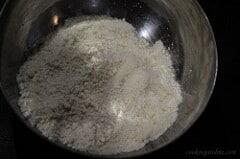
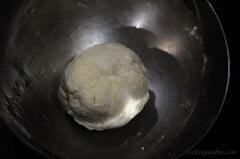
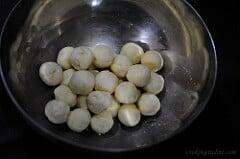
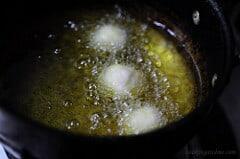
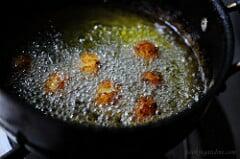
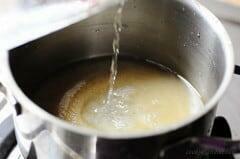
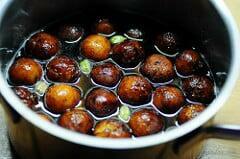
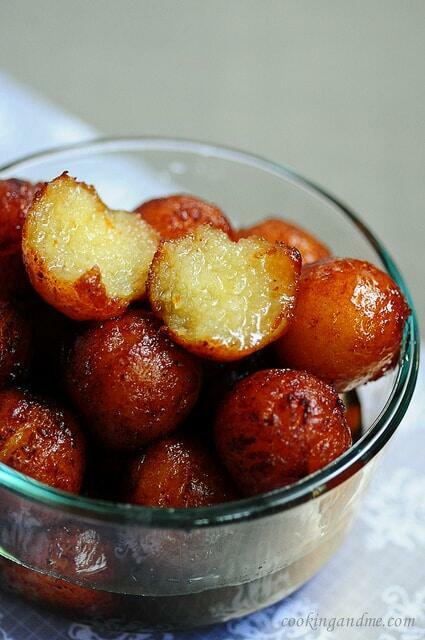
Hey Nags,
I have started cooking recently and should say that your website has helped me a lot . Many thanks to you. I tried making gulab jamun with Gits and thats the ready made mix thats available here in the UK and people say that its really good. I dont know what went wrong but when i started frying them the balls just got disfigured and lost their shape . At the end it tasted really good but didnt look nice. It would be nice if you could suggest a solution for this problem .
If your gulab jamun disintegrates in the oil, it must be because the dough had too much water (or soda or baking powder – not applicable here since you used a readymix). Make sure you don't immediately add the quantity of water they mention on the box. It differs depending on humidity, etc.
Making this today, bought khoya from mustafa and waiting for this to come to room temp
Love those deep fried balls of heaven ! and kudos on completing Project 365
Only very few Kitchen Khiladis like you can make even a simple gulab jamun post so catchy for eyes to droll over and mind to register what to cook in kitchen next :).Loved the last jamun pic.
Hi,
The jamuns look really wonderful. A few questions if you don't mind… I have had disappointing results a few times with kneading the dough, either it breaks or it is hard. Is there any tips for kneading?
You don't need to knead the mixture actually. Just mix well until the powder is well incorporated into the liquid. If it forms cracks, that means it needs a bit more water.
Hot gulab jamun topped with vanilla ice cream is just dreamy! 🙂
Thank you so much for sharing! These are amazing and I’ve been inspired to feature this post in my Friday Food Fetish roundup. If you have any objections, please let me know. Moar, moar, MOAR please 🙂
Hi,
Use the left over sugar syrup by making double ka meetha.